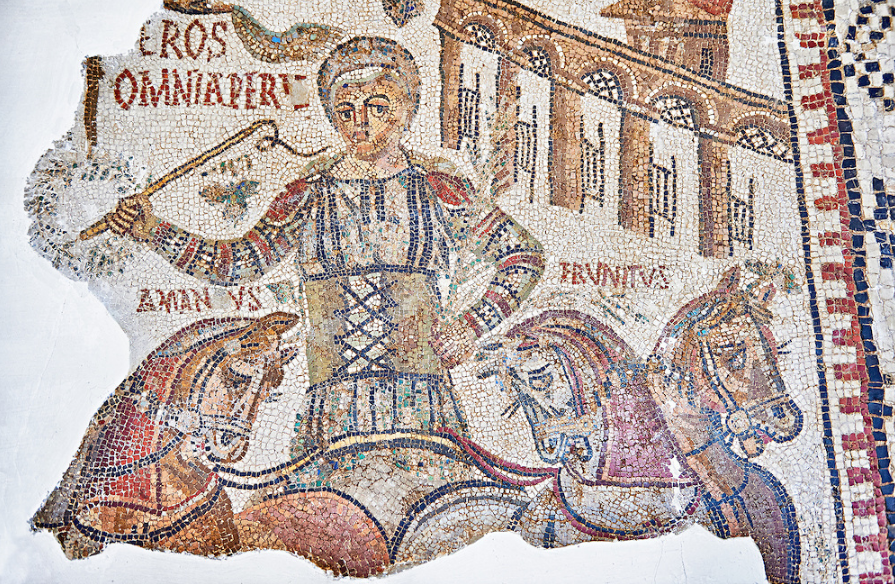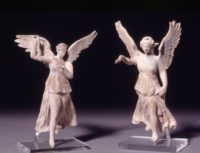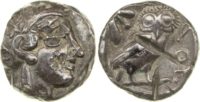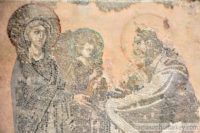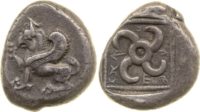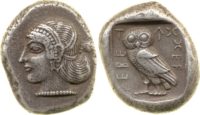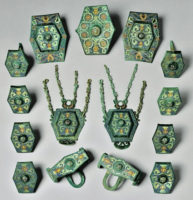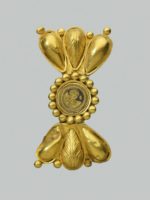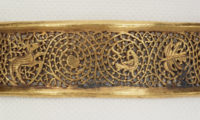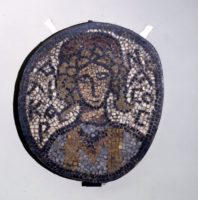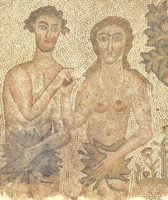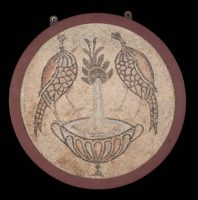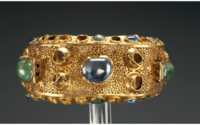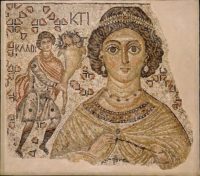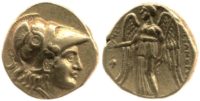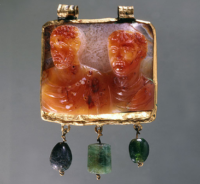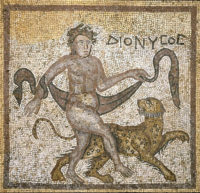4th century Roman mosaic panel of Eros, a circus chariot rider of the Red Fraction. From Tunisia. The Bardo Museum, Tunis, Tunisia.
Siege of Constantinople in 1453 (fresco), Romanian School, (16th century) – Church of St George, Voronet Monastery, Bukovina, Romania.
Terracotta Figure of Winged Nike Flying, wings raised, Period: Hellenistic 1stc(late) BC-1stc(early) (circa) Acquisition Date: 1893. Her left leg outstretched (perhaps coming down to land), her right hand raised and holding a small wreath, her left hand pulling at the drapery on her left thigh, wearing peplos belted high up under the breasts leaving her left bare, her left leg emerging from the garment at thigh level, wavy centrally parted hair drawn back into. Made in: Myrina, Anatolia (Modern Turkey) British Museum is closed 24, 25 and 26 December and 1 January, but is open every other day of the year.
Museum Description: “Silver coin.(obverse) Head of Athena right, wearing earring and crested helmet decorated with olive-leaves. (reverse) Owl within incuse square, right; to left, olive-spray and crescent.” Period: 5 th century B.C., Minted in: Athens, Greece; Excavated/Findspot: Cilicia (Anatolia, Modern Turkey). British Museum is closed 24, 25 and 26 December and 1 January, but is open every other day of the year. Fast facts about the British Museum: Founded: 1753, Collection size: 8 million objects, Oldest object in the collection: Stone chopping tool (nearly 2 million years old).
Mosaic Panel. Period: Early Byzantine; circa: Late 6th – early 7th century. Findspot: Istanbul, Kalenderhane Mosque excavations. Decorated the southern niche of the apse; it depicts the earliest presentation scene, the hypapante, found in Istanbul. Materials: stone, glass. In the Istanbul Archaeological Museum collections, there are rich and very important works of art belonging to various civilizations from the regions from Africa to Balkans , from Anatolia and Mesopotamia to Arab Peninsula and Afghanistan that were in the borders of the Ottoman Empire.
Silver Coin, Period: 5th. century B.C. 480BC-460BC (circa). Minted in Lycia, Anatolia, Modern Turkey. Ruler: Taththivaibi Museum Description: “(obverse) Griffin, curved wing, seated left; right forepaw raised. (reverse) Tetraskeles left; in dotted incuse square.” British Museum is closed 24, 25 and 26 December and 1 January, but is open every other day of the year. Fast facts about the British Museum: Founded: 1753, Collection size: 8 million objects, Oldest object in the collection: Stone chopping tool (nearly 2 million years old).
Silver Coin, Period: 5thc. B.C., Ancient Greek circa: 480 B.C-460 B.C, Ruler: Taththivaibi, Minted in: Lycia (Modern Turkey, Anatolia) Museum Description: Head of Aphrodite left, rows of formal curls on fore-head, hair fastened by band passing three times round it, and caught up behind; truncation on neck dotted; symbol, resembling T on neck. (reverse) Tetraskeles right, members of which divide the legend; in inner ring, owl standing left, head to front; symbol at beginning of inscription: the whole. British Museum is closed 24, 25 and 26 December and 1 January, but is open every other day of the year. Fast facts about the British Museum: Founded: 1753, Collection size: 8 million objects, Oldest object in the collection: Stone chopping tool (nearly 2 million years old).
[xyz-ihs snippet="British-Museum"]Harness Ornaments. Period: Late Roman; circa: 200–400. Geography: Made in Thrace (possibly). The Metropolitan Museum of Art (New York) is one of the world’s largest and finest art museums. Its collection includes more than two million works of art spanning five thousand years of world culture, from prehistory to the present and from every part of the globe. Public Hours: 10:30 a.m.–5:30 p.m. Open seven days a week.
Three Fragments of a Buckle or Brooch. Material: Gold. Period: Late Roman. Found/Acquired: Anatolia, Turkey (?) British Museum is closed 24, 25 and 26 December and 1 January, but is open every other day of the year. Fast facts about the British Museum: Founded: 1753, Collection size: 8 million objects, Oldest object in the collection: Stone chopping tool (nearly 2 million years old).
Bracelet, Period: Late Roman circa: 379 – 395 A.D. Medium: Gold. Dimensions: 1.4 × 6.3 cm (9/16 × 2 1/2 in.) Museum Description: “A simple gold band with plain flanged edges forms this openwork bracelet. A vegetal scroll weaves across the surface of the band, into which hunting scenes are inserted. On one side a hound chases a stag, while on the other a hound pursues a hare. ”
The J. Paul Getty Museum at the Getty Center in Los Angeles houses European paintings, drawings, sculpture, illuminated manuscripts, decorative arts, and photography from its beginnings to the present, gathered internationally.
Circular mosaic. Personification of the city of Halicarnassus. Period: Late Roman; circa: 4th c.; Excavated/Place: Halicarnassus, Modern Turkey, Aegean Region, Anatolia. Materials: stone. Dimensions: Height: 54.5 centimetres Width: 49.5 centimetres. British Museum is closed 24, 25 and 26 December and 1 January, but is open every other day of the year. Fast facts about the British Museum: Founded: 1753, Collection size: 8 million objects, Oldest object in the collection: Stone chopping tool (nearly 2 million years old).
Fragment of a Floor Mosaic- Adam and Eve, Period: late 400s-early 500s, Early Byzantium, Northern Syria. The Cleveland Art Museum Hours: Tuesdays, Thursdays, Saturdays, Sundays 10:00 a.m.–5:00 p.m. Wednesdays, Fridays 10:00 a.m.–9:00 p.m. Closed Mondays.
Silver coin, Period: 4 th. century B.C. 378BC-372BC (circa), Ruler: Datames, Minted in: Tarsus (Modern Turkey, Mersin Province) Museum Description: “Silver coin.(obverse) Baal seated r. (reverse) An standing r. facing Tarkumuwa.” British Museum is closed 24, 25 and 26 December and 1 January, but is open every other day of the year. Fast facts about the British Museum: Founded: 1753, Collection size: 8 million objects, Oldest object in the collection: Stone chopping tool (nearly 2 million years old).
Mosaic, Two Peacocks Perch on a Fountain, Period: Early Byzantine, circa: A.D. 450–462. The MFA is open 7 days a week. Monday and Tuesday 10 am–5 pm, Wednesday–Friday 10 am–10 pm, Saturday and Sunday 10 am–5 pm.
Bracelet, Period: Late Roman circa: about 379 – 395 A.D., Materials: Gold, emeralds, sapphires, and glass, Dimensions: 2.8 × 5.8 cm (1 1/8 × 2 1/4 in.). The J. Paul Getty Museum at the Getty Center in Los Angeles houses European paintings, drawings, sculpture, illuminated manuscripts, decorative arts, and photography from its beginnings to the present, gathered internationally.
Harness; Carriage Fitting; Period: Late Roman; 4th. c.; Found: Anatolia, Turkey. British Museum is closed 24, 25 and 26 December and 1 January, but is open every other day of the year. Fast facts about the British Museum: Founded: 1753, Collection size: 8 million objects, Oldest object in the collection: Stone chopping tool (nearly 2 million years old).
Fragment of a Floor Mosaic with a Personification of Ktisis, Period: Early Byzantine circa: 500–550, with modern restoration. Materials: Marble and glass. The Metropolitan Museum of Art (New York) is one of the world’s largest and finest art museums. Its collection includes more than two million works of art spanning five thousand years of world culture, from prehistory to the present and from every part of the globe. Public Hours: 10:30 a.m.–5:30 p.m. Open seven days a week.
Gold Coin of Alexander the Great (obverse) Head of young Herakles, right, in lion scalp. Date: 323BC-280BC (circa). (reverse) Zeus seated, left, holding eagle and sceptre. Minted in: Anatolia, Modern Turkey. British Museum is closed 24, 25 and 26 December and 1 January, but is open every other day of the year. Fast facts about the British Museum: Founded: 1753, Collection size: 8 million objects, Oldest object in the collection: Stone chopping tool (nearly 2 million years old).
[xyz-ihs snippet="British-Museum"]Busts of Two Emperors, Period: Roman, Circa: Late 3rd-early 4th century, Material: Chalcedony on gold. The museum is open to the public Tuesday through Sunday, 11:30 a.m.–5:30 p.m., except for federal holidays.
Mosaic Pavement; Period: Late Roman; circa: 4th c.; Excavated/Place: Halicarnassus, Modern Turkey, Aegean Region, Anatolia. Materials: stone. Dimensions: Height: 1.4 metres Width: 1.36 metres. Museum Description: Panel from a mosaic pavement, Dionysos dances to the right, with the panther running behind and looking up at him. Dionysos wears a grey-green wreath, and carries a strip of red drapery edged with black. The name of Dionysos is inscribed in Greek.
British Museum is closed 24, 25 and 26 December and 1 January, but is open every other day of the year. Fast facts about the British Museum: Founded: 1753, Collection size: 8 million objects, Oldest object in the collection: Stone chopping tool (nearly 2 million years old).
Silver Coin, Period: 4 th century B.C. 330BC (circa); Museum Description: “Silver coin.(obverse) Head of nymph Sinope waring earring. (reverse) Eagle above dolphin.” Minted in: Sinope (Modern Turkey, Black Sea Region Sinop Province) British Museum is closed 24, 25 and 26 December and 1 January, but is open every other day of the year. Fast facts about the British Museum: Founded: 1753, Collection size: 8 million objects, Oldest object in the collection: Stone chopping tool (nearly 2 million years old).


